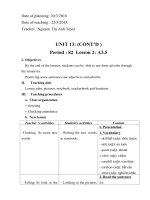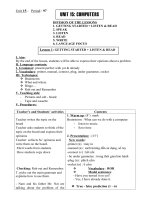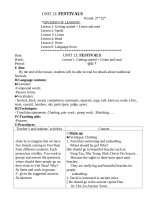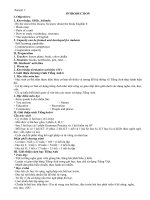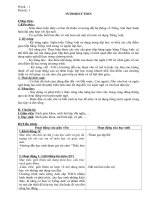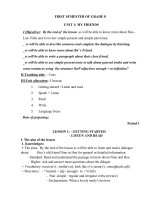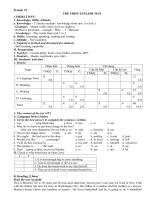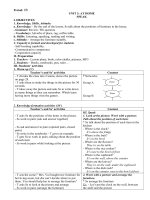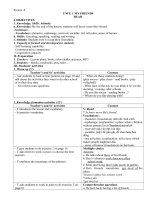unit 13 festivals tiếng anh 8 sách cũ nguyễn thị thược thư viện giáo án điện tử
Bạn đang xem bản rút gọn của tài liệu. Xem và tải ngay bản đầy đủ của tài liệu tại đây (1.61 MB, 22 trang )
<span class='text_page_counter'>(1)</span><div class='page_container' data-page=1>
UNIT 13:
<b>FESTIVALS</b>
Period: 27th-<sub>32</sub>nd
*DIVISION OF LESSONS:
Lesson 1: Getting started + Listen and read
Lesson 2: Speak
Lesson 3: Listen
Lesson 4: Read
Lesson 5: Write
Lesson 6: Language focus
***********************************************
Date: UNIT 13:
<b>FESTIVALS</b>
Week: Lesson 1: Getting started + Listen and read
Period: @& ?
<b>I/ Aim:</b>
<b> By the end of the lesson, students will be able to read for details about traditional </b>
festivals.
<b>II/Language contents:</b>
♣Grammar:
-Compound words.
-Passive forms.
♣Vocabulary:
- festival, fetch, award, competition, teammate, separate, urge, yell, keen on, make a fire,
team, council, bamboo, rub, participate, judge, upset.
<b>III/Techniques:</b>
<b>- True/false statements ,Chatting, pair work , group work , Matching, …</b>
<b>IV/Teaching aids:</b>
<b>-Pictures.</b>
<b>V/Procedures:</b>
Teacher’s and students’ activities Content
-Asks Ss to imagine that we have
five friends coming to Viet Nam
from different countries. Each
person has a hobby. You work in
groups and answer the questions
where should these people go on
their visits to Viet Nam? Why?
-Ss listen and work in groups.
-T. gives the suggested answers.
-Ss takenote.
1/<i><b>Warm up</b></i>:
♣Technique: Chatting
1. Tom likes swimming and sunbathing.
Where should he go? Why?
[He should go to beautiful beaches such as:
Vung Tau, Nha Trang, Ninh Chư or Do Son,etc…
-Because the sights in there have quiet sand
beaches.
They are really big and beautiful beaches for
people
sunbathing.
2. David is interested in ancient cities.
</div>
<span class='text_page_counter'>(2)</span><div class='page_container' data-page=2>
-T. introduces the dialogue.
-Ss listen.
“Ba invites his friend Liz to a
traditional festival in the North of
Viet Nam” Do you know what
kind of festival it is? –Yes. It’s the
rice- cooking festival.
<b>-Who are talking in the conversation?</b>
<b> +They’re Ba and Liz.</b>
<b>-Where are they now? </b>
<b> +They’re at the rice-cooking festival.</b>
<b>-How many competitions are there </b>
<b> in the rice-cooking festival? +Three.</b>
<b>-What are they? + They’re </b>
<b>water-fetching, fire-making and rice-cooking</b>.
-T.explains Newwords. Ss listen
and give the meaning of the words.
-T.reads - Ss repeat. (Chorally then
individually).
+Using explaining: “a day or
period of religious or other
celebration”.
+T.uses explaining: “to go to get
something and bring it back”.
+Using: “translation”.
+Using: “translation”.
+Using explaining: “a group of
people forming one side in a game”
-Because in there has many ancient cities.
3. Huckleberry likes mountain-climbing.
[ He should go to Sapa.
-Because in there it has tall and beautiful mountains.
4. Oliver is keen on pottery.
[He should go to Lai Thieu village in Binh Duong
province or Champa tribes in Ninh Thuan province
or Bat Trang village in Hai Duong provine.
-Becase these are famous places for pottery in Viet
Nam country.
5. Robinson is fond of crowded places.
[ He should go to Ho Chi Minh or a certain festival.
-Because this is the crowded place in Viet Nam.
2/<i><b>Presentation</b></i>:
The Rice-cooking Festival
*Newwords:
- ’festival (n): lễ hội
- fetch (v): đi lấy, mang về
- a’ward (v): tặng, tặng thưởng
- compe’tition (n): cuộc tranh tài
- ’teammate (n): đồng đội
</div>
<span class='text_page_counter'>(3)</span><div class='page_container' data-page=3>
+T.explains: “sb/sth from sb/sth”.
+Using explaining: “To make a
person / animal move quickly”.
+T.explains: “To shout loudy”.
-Using translation.
-Using picture.
-Using example.
-Using translation.
-Using example.
-Using mime.
-Using synonym: take part in
-Using exaplanation.
-Using translation.
-T.checks voc by using:
“Matching”
-T.explains compound words.
-Ss takenote.
-T.has Ss reminds.
-Ss remind.
-Lets Ss listen to the tape. Ss listen.
-Then calls them to practice.
-Ss practice.
-T. corrects their pronunciation if
necessary.
-T.asks them to read the statements
and check (V ) the boxes. Using
the
information in the dialogue. Ss
work in pairs.
-T. asks Ss to give their answers
and correct the false sentences.
-Ss answer and correct.
-T. remarks.
- urge (v): thúc giục
- yell (v): hét to, la to (cổ vũ)
-keen (on)(adj.): say mê, ham thích
-make a fire (v):nhóm lửa
-team (n): đội, nhóm
-’council(n): hội đồng
- bam’boo(n): tre
- rub(v):chà, cọ xát
-par’ticipate(v): tham gia
- judge(n): giám khảo
- up’set(adj.): bực mình, khó chịu
♣Technique: Matching.
@Grammar:
*<i><b>Compound words</b></i>:
N –V+ing:
<i>Ex: One fetches the water </i>"(a) water-fetching.
Viet Nam exports rice "(a) rice-exporting.
*<i><b>Passive forms</b></i>: (in present)
<i>Ex: The fire is made in the traditional way.</i>
Pieces of bamboo are used to make the fire.
3/<i><b>Practice:</b></i>
<b>3.1/p121, 122.</b>
-The dialogue in the book.
<b>3.2/p122 . </b>
♣Technique: True / False?
*Answers:
a/ F ( One person from each team takes part in the
water-fetching contest).
b/ F (One person must take one water bottle).
c/ T
d/ F (Pieces of bamboo are used to make the fire).
e/ F ( In the final contest, the judges taste the rice).
f/ T.
</div>
<span class='text_page_counter'>(4)</span><div class='page_container' data-page=4>
-T. asks Ss to work in groups.
-Ss work in groups.
-T. has Ss answer the questions.
-Ss answer.
-T. corrects their answers and gives
Marks.
-Ss takenote into their notebooks.
-T. writes on the board and
explains how to prepare a good
lesson at home.
-Ss copy down into their
notebooks.
a/ How many competitions do people enter in
cooking festival?- Three competitions.
b/In a water-fetching competition, what do people do?
- People fetch water.
c/ What about a rice-cooking competition?
- They have to separate the rice
from the husk and then cook the rice
d/ How about a fire-making competition?
- They try to make a fire by rubbing
pieces of bamboo together.
5/<i><b>Homework</b></i>:
-Practice speaking the dialogue with your partner.
-Learn by heart Newwords and Grammar.
-Prepare: UNIT 13 (Cont.) Lesson 2: Speak.
+Put the sentences in the correct order.
+Write 3 festivals and the ways to take part in them.
*Comments:
Date:
UNIT 13:
<b>FESTIVALS</b>
Week: Lesson 2: Speak
Period: @&?
<b>I/ Aim:</b>
</div>
<span class='text_page_counter'>(5)</span><div class='page_container' data-page=5>
special event.
<b>II/Language contents:</b>
♣Grammar:
-Review present perfect tense, want somebody to do something.
♣Vocabulary:
-Tidy, sweetie.
<b>III/Techniques:</b>
-Brainstorming, Find things in common, Rub out and remember, Ordering, Mapped
dialogue,
pair work, group work,…
<b>IV/Teaching aids:</b>
<b>-Pictures.</b>
<b>V/Procedures:</b>
Teacher’s and students’ activities Content
-T. asks Ss to answer the questions
+ Do you like Tet? –Yes, I do.
+ What do you do berore Tet?
I go to the market to buy
something such as: clothes, food
and drink and tidy my bedroom...
-T. introduces some festivals.
-Ss observe.
-T. explains Newwords.
- Ss listen and take note.
-T. reads – Ss repeat (chorally then
individually).
-Checking Voc: “Rub out and
1/<i><b>Warm up</b></i>:
♣Technique: Brainstorming
House (decorate, paint)
Cakes (make)
Food (buy)
Furniture (clean)
Drinks
Clothes Shoes Room (paint)
Find things in common.
Lễ hội đua thuyền truyền thống Lễ hội chọi gà truyền thống
Hội thi đấu vật Lễ hội chọi trâu- Đồ Sơn
2/<i><b>Pre-speaking</b></i>:
*Newwords:
-tidy (v): sửa soạn, thu dọn, dọn dẹp
(adj.): sạch sẽ, gọn gàng, ngăn nắp
-’sweetie (n): bé ngoan, bé cưng
♣Technique: “Rub out and remember”
Preparation
</div>
<span class='text_page_counter'>(6)</span><div class='page_container' data-page=6>
remember”.
-T. shows the picture of Mrs.
Quyen and Lan, then explains what
they are doing.
-T. asks Ss to put the sentences in
the correct order with the example
-T. corrects if necessary.
-T. asks Ss to choose one of the
festivals (p.123) and make up
their own dialogues.
-Ss work in pairs.
-T. helps Ss to practice while they
are working.
-T. calls some pairs to demonstrate
their dialogues for the class.
-Ss give feedback.
-T. corrects if necessary.
-Ss takenote.
3/<i><b>While-speaking</b></i>:
♣Technique: Ordering
*Put their sentences in the correct order.
A-F-C-H-D-J-B-G-E-I
Ex: A: Have you tidied the bedrooms?
F: Yes, I have. Where are you going , Mom?
……….
I: Bye, Mom.
*Talk about preparations for another festival.
♣Technique: Mapped dialogue.
a) A: Do you want to participate in a village festival,
B?
B: Yes, I’d like very much.
A: Do you want to be a member of a team in a
contest?
B: No, I don’t. I have no skill, I want to be only
a watcher.
b) A: Are you ready to participate in your school
festival, B?
B: I am not ready, but I’m preparing.
A: What will you do on that day?
B: I help my form teacher to realize a wall-paper.
A: Ah, good. Try yourself.
B: Thanks.
c) A: Have you prepared something to participate in
a spring festival?
B: But what kind of spring festivals?
A: Rice-cooking, for example.
B: I am not good in cooking, so I won’t be a
member of any teams.
A: How about participating as a watcher?
B: Oh, I would like very much!
d) A: Have you ever been in a harvest festival?
B: Yes, I have. That’s very joyful.
</div>
<span class='text_page_counter'>(7)</span><div class='page_container' data-page=7>
-T. asks some questions.
-Ss answer.
-T. corrects and gives marks.
-T. says.
-Ss write down.
A: What’s the meaning of that festival?
B: We express the joy of good harvests.
e) A: Is there a flower festival in your country?
B: Yes, there is. It is a very great festival.
A: When is it organized?
B: In the spring, before and after the first day of
the lunar new year.
A: I think there are a lot of kinds of flowers.
B: Yes, sure. You will see it in only some weeks.
4/Post-speaking/Marks
a) How often does your school have the festivals?
-Sometimes.
b) Could you tell me some names of the festivals?
-Mid-Autumn Festival, Teacher’s Day, …
c) Would you like to take part in the school festivals?
-Yes, I would love to.
d) What do you often do before the festivals?
-I often write the letter to invite my old friends.
I want them come to see.
5/Homework:
-Learn by heart new words.
-See the lesson at home.
-Prepare: UNIT 13 (Cont.) Lesson 3: Listen.
+Listen to the tape at home first.
-Fill in the gaps.
-Complete the notes.
*Comments:
Date: UNIT 13:
<b>FESTIVALS</b>
Week: Lesson 3: Listen
Period: @&?
<b>I/ Aim:</b>
<b> By the end of the lesson, students will be able to listen about the Robinson family are </b>
making preparations for Tet.
<b>II/Language contents:</b>
♣Grammar:
</div>
<span class='text_page_counter'>(8)</span><div class='page_container' data-page=8>
♣Vocabulary:
-pomegranate, peach blossoms, marigolds, dried water melon seeds, spring rolls,
apricot blossoms,
<b>III/Techniques:</b>
-Grid, Filling gap, Prediction, Networks, Matching, True/ False statements, pair work,
group work,…
<b>IV/Teaching aids:</b>
<b>-Pictures.</b>
<b>V/Procedures:</b>
Teacher’s and students’ activities Content
-T. guides Ss to play.
-Ss play in groups.
-Calls on some groups to give the
results.
-Ss give.
-T. corrects and gives marks.
-T. explains new words.
-Ss give the meaning of the
words.
-T. reads.
-Ss repeat (chorally, individually)
-T. checks voc.
-Asks Ss to read the statements on
p.124 and guess the words to fill
in the blanks.
1/Warm up/Marks
♣Technique: Networks
vegetables egg carnation aster (cúc tây)
(cẩm chướng) lily (huệ, đại
tướng quân)
cabbage pom-pom
(cúc trắng)
meat spring roll chrysanthemum
(cúc đại hoá)
gerbera (đồng tiền kép)
coconut
grapefruit
mango custard – apple (trái na)
pineapple
apple
papaya
2/Pre-Listening:
*New words:
-’pomegranate (n): quả lựu
-peach ’blossom(s) (n): hoa đào
-’marigold(s) (n): cúc vạn thọ
-dried ’water ’melon seeds (n): hạt dưa
-spring roll(s): chả giò
-apricot ’blossom(s): hoa mơ
♣Technique: Matching
♣Technique: Prediction
a)…….. c)……..
b)…….. d)……..
3/While-listening:
♣Technique: Filling gap
<b>3.1/124</b>
food <sub>flower</sub>
s
</div>
<span class='text_page_counter'>(9)</span><div class='page_container' data-page=9>
-Asks Ss to listen and fill in the
gaps.
-Ss listen and fill in.
-Calls on some Ss to give
their answers.
-Ss give.
-T. plays tape again and corrects.
-T. asks Ss to copy the grid p.124
in their notebooks and fill in the
gaps with the information taken
from the statements above.
-T.calls on some Ss to give their
answers.
-T. corrects if necessary.
-Ss takenote.
<i>The Robinson family are making preparations</i>
<i> for Tet</i>
<i> </i>
+ Answer keys:
a/ Mr. Robinson / flower market
b/ traditional
c/ dried watermelon seeds.
d/ make
♣Technique: Grid
<b>3.2/124</b>
+ Complete the notes:
*TAPE TRANSCRIPT:
Mrs. Robinson: John, I want you to go to the
flower market for me, please.
Mr. Robinson: What do I have to buy?
Mrs. Robinson: Some peach blossoms and a bunch
of flowers.
Mr. Robinson: What sort of flowers?
Mrs. Robinson: Marigolds, because they are
traditional at Tet.
Mr. Robinson : Anything else?
Mrs. Robinson: No, but I need Liz to do a few
things.
Liz : What is that, mom?
Mrs. Robinson: Are you busy?
Liz : No. Do you need something?
Mrs. Robinson: Yes. Go to the market and pick up
<b>Things to do</b>
<b>Mr. Robinson: go to the flower market to buy </b>
<b> peach blossom and a bunch of </b>
<b> marigolds.</b>
<b>Liz: go to the market to buy candies and </b>
<b> a packet of dried watermelon seeds.</b>
<b>Mrs. Robinson</b>: <b>go to Mrs. Nga’s to learn how to</b>
</div>
<span class='text_page_counter'>(10)</span><div class='page_container' data-page=10>
-T. gives sentences.
-Ss choose True / False. And
correct the false sentences.
-T. corrects and gives Ss marks.
-T. writes on the board and
explains carefully. Ss takenote.
some candies and one packet of
dried watermelon seeds, please.
Liz : Okay. What are you going to do?
Mrs. Robinson: I’m going to Mrs. Nga’s. She’s
going to show me how to make
spring rolls.
4/<i><b>Post-listening/Marks</b></i>
♣Technique: True/False?
a/ Mr. Robinson goes to the flower market. <sub></sub><b>T</b>
b/ Mr. Robinson asks Mrs. Nga how to make
spring rolls. <sub></sub><b>F (Mr Mrs)</b>
c/ Liz goes to the supermarket to buy fish <sub></sub><b>F. </b>
<b> (supermarket market ; fish candies / </b>
<b> dried watermelon seeds).</b>
5/<i><b>Homework</b></i>:
-Learn by heart Newwords.
-Listen to the tape at home again.
-Prepare: UNIT 13 (Cont.) Lesson 4. Read.
+Find out Newwords.
+Read the passage.
+Answer the questions.
*Comments:
Date:
UNIT 13: FESTIVALS
Week: Lesson 4: Read
Period: @&?
<b>I/ Aim:</b>
<b> By the end of the lesson, students will be able to read the passages for details about </b>
Christmas.
<b>II/Language contents:</b>
♣Grammar:
-Passive forms.
♣Vocabulary:
-Christmas carol, patron saint, jolly, Santa Claus, spread, poem, decorate, greetings,
custom.
</div>
<span class='text_page_counter'>(11)</span><div class='page_container' data-page=11>
<b>- Chatting, Brainstorming, Grid, True/False statements, Jumbled words, Ask and answer </b>
drill, pair work , group work ,…
<b>IV/Teaching aids:</b>
<b>-Pictures.</b>
<b>V/Procedures:</b>
Teacher’s and students’ activities Content
-T. asks some questions.
-Ss answer.
-T. remarks.
-T. tells Ss to talk about the Noel.
-Using “Brainstorming”
-T. presents each word.
-Using translation.
-Using translation.
-Using synonym:“happy& cheerful”
-Using explaining: “A person who
brings presents of Christmas”.
-Using translation.
-Using example.
-Using translation.
-Using example.
-Using translation.
-T. reads and writes it on the board.
-T. has Ss give the meaning of the
words. Ss give the meanings.
1/<i><b>Warm up</b></i>:
♣Technique: Chatting
+What do you often do at Christmas?
-I often send Christmas cards to my friends //
give cards to each other
+Do you celebrate Christmas? – Yes / No.
+When was the Christmas tree first decorated?
-In the early 1500s.
2/<i><b>Pre-reading</b></i>:
♣Technique: Brainstorming
Christmas carols Christmas card
Christmas tree Santa Claus
*Newwords:
-’Christmas ’carol (n): bài thánh ca giáng sinh
-’patron saint (n): thánh bảo hộ
-’jolly (a): vui nhộn, vui vẻ
-’Santa Claus (n): ông già Noel
-spread - spread – spread (v): lan truyền
-’poem (n): bài thơ
-’decorate(v): trang hồng, trang trí
- ’greetings (n): lời chào hỏi
-’custom (n): phong tục
</div>
<span class='text_page_counter'>(12)</span><div class='page_container' data-page=12>
-T. reads – Ss repeat.
(Chorally then individually).
-T. checks Newwords by using:
“Jumbled words”.
-T. sticks flashcards on the board
and asks Ss to rewrite these words.
Then some Ss give their answers on
the board.
-T. remarks.
- Ss takenote.
-T. gives the example and explains.
-Ss takenote.
-Asks Ss to match the column A
and B.
-Ss match.
-T. remarks.
-Ss. takenote.
-T.plays tape for Ss twice and asks
them to listen. Ss listen. Then read
the passage in silence.
-T. hangs a poster with Grid on the
board. Ss copy.
-T. asks Ss to read the paragraph
again and complete the grid.
-T. calls on some Ss to fill in the
gaps in the grid.
-T. remarks and corrects.
-Ss. takenote.
♣Technique: Jumbled words
+Answers:
a. Santa Claus f. custom
b. jolly g. decorate
c. carol h. greetings
d. spread i. poem
e. patron saint
*Grammar:
<b>Simple past in passive</b>
Ex: Christmas songs were performed for people in
towns and villages.
♣Technique: Matching
A B
1. to send a. to church
2. to decorate b. Christmas pudding
3. to give c. a carol like Jingle Bell
4. to go d. a tree
5.to sing e. Christmas card
6.to eat f. presents
Keys:
<sub></sub> 1e, 2d, 3f, 4a, 5c, 6b.
3/<i><b>While-reading</b></i>:
3.1/p.126.
♣Technique: Grid
<b>Christmas</b>
<b>specials</b>
<b>Place of origin</b> <b>Date</b>
<i>The Christmas </i>
<i>tree</i>
Riga <i>Early1500</i>
<i>s</i>
<i>The Christmas </i>
card
<i>England</i> Mid-19th
century
Christmas carols <i>No </i>
<i>information</i>
<i>800 years</i>
<i>ago</i>
<i>Santa Claus</i> USA <i> 1823</i>
s u o m t c p d s e a r o n t r p a t s i a n
l o c r a
e m o p
g e e t r g n s i
d c r t e e o a
</div>
<span class='text_page_counter'>(13)</span><div class='page_container' data-page=13>
-T. asks Ss to ask and answer the
questions on (p.126) .
-Ss work in pairs.
-Several pairs practice asking and
answering in front of the class.
-Then they give their answers on the
board.
-T. remarks and corrects.
-T. gives statements and asks Ss to
put T/F. Ss put and correct the
false sentences.
-T. corrects and gives marks.
-Ss takenote.
-T. writes on the board and explains
how to do the exercise and prepare
a good lesson at home.
-Ss takenote into their notebooks.
<b>3.2/p.126</b>
♣Technique: Ask and answer
<b>*Answer the questions:</b>
a/ More than a century ago.
b/ He wanted to send Christmas greetings to
his friends.
c/ 800 years ago.
d/ An American professor Clement Clark Moore.
e/ On the description of Saint Nicholas in Professor
Moore’s poem.
4/<i><b>Post-reading/Marks:</b></i>
♣Technique: True/False statements
a) The Christmas tree came to the USA 800 years
ago.( F. in the 1800s.)
b) The English man wanted to send Christmas
greetings to his friends. (T)
c) Christmas songs were first performed in 1823.
(F. 800 years ago)
d) On the description of Saint Nicholas in
Professor Moore’s poem. (T)
e) Santa Claus is jolly and wear a red suit. (T)
5/<i><b>Homework</b></i>:
-Use the information in the grid to write the brief
paragraphs.
-Read the text + Answer the questions again.
-Learn by heart Newwords.
-Prepare: UNIT 13 (Cont.) Lesson 5. Write.
+ Fill in the gaps
+ Write a similar report
</div>
<span class='text_page_counter'>(14)</span><div class='page_container' data-page=14>
Date: UNIT 13:
<b>FESTIVALS</b>
Week: Lesson 5: Write
Period: @&?
<b>I/ Aim:</b>
<b> By the end of the lesson, students will be able to write a report on a festival they have </b>
joined.
<b>II/Language contents:</b>
♣Grammar:
-Review the simple past, present simple.
♣Vocabulary:
-Chopsticks, councilor.
<b>III/Techniques:</b>
<b>- Lucky numbers, Filling gap, Ask and Answer Drill, Memory game, pair work , group </b>
work.
<b>IV/Teaching aids:</b>
<b>-Pictures.</b>
<b>V/Procedures:</b>
Teacher’s and students’ activities Content
-T. hangs a picture on the board and
</div>
<span class='text_page_counter'>(15)</span><div class='page_container' data-page=15>
asks Ss to look at it carefully.(for
about 20’’). Then T. puts it away.
-T. asks some questions.
-Ss listen carefully and answer.
-Then T. puts the picture on the
board again and asks Ss to check
their answers.
-T. writes 9 numbers on the board
from 1-9. T. tells each number is for
a question but 3 of them are lucky
numbers. If Ss choose a lucky
number, they don’t have to answer
any question but they get 2 points
and they can get another number.
-T. divides the class into 2 teams.
-T. asks Ss to fill in the gaps by
using the information in the dialogue
on page 121 to complete the report
page 127. T. asks Ss to work in pairs
a/ How many people are there in the picture? 7.
b/ What are they doing?
-They are cooking rice (or they are participating
in the rice cooking competition).
c/ Name some things in the picture?
-Rice, basket, pans, bamboo sticks, paper fans,
chopsticks, a flag.
2/<i><b>Pre-writing</b></i>:
♣Technique: Lucky numbers
a. What do you call the festival where people have to
cook rice? – The rice-cooking festival.
b. How many competitions are there in the
cooking festival? What are they? – There are 3.
They are water-fetching, fire-making, and
cooking.
c. Lucky number.
d. What do people use to fetch water? – Bottles.
e. Lucky number.
f. Do they use pieces of wood to make fire?
- No, they don’t. (pieces of bamboo)
g. What do people have to do before they cook the
rice?
- They have to separate the rice from the husk.
h. Lucky number.
i. How many people are there altogether in a team
taking part in the rice-cooking festival?
- There are nine : one for water-fetching, two for
fire-making, and six for rice-cooking.
3/<i><b>While-writing</b></i>.
<b>3.1/p126</b>
♣Technique: Gap fill
*Answers:
</div>
<span class='text_page_counter'>(16)</span><div class='page_container' data-page=16>
and write their As on a piece of
paper.
-T. collects Ss’ papers and corrects.
-T. asks Ss to ask and answer the
questions. Ss practice in pairs.
-T. asks Ss to write a similar report
on a festival they’ve joined recently
by connecting the sentences from a)
to g) to make it into a report.
-T. calls on some Ss to read their
reports again. Ss read.
-T. corrects their mistakes if
necessary.
-Ss. takenote.
-T. guides.
-Ss write.
-T. corrects their mistakes and gives
Ss marks.
-Ss takenote.
3. water-fetching 8. six
4. run 9. separate
5. water 10. added
<b>3.2/p127</b>
<b> Suggestion:</b>
This report shows how the Mid-Autumn festival
was held in my neighborhood .
The Mid-Autumn festival was held on the 15th<sub> of </sub>
August (according to Lunar Calendar). This festival
was specially organized for children.
It was held in the yard of the Cultural House in my
village. The main festival lasted for about three
hours when the moon is at its fullest. During the
festival, children took part in various activities like:
singing and shouting, wearing masks, parading on
the roads and banging the drums.
Besides, children ate a very special cake called
Moon Cakes. They are filled with lotus seeds,
orange peel, ground beans and sometimes egg and
pork fat for flavor.
Children went on playing traditional games until
mid- night.
I think this festival is a very special occasion for
Vietnamese people and specially for children to play
and enjoy on a variety of activities. Moreover,
children would understand more about Vietnamese
traditions.
4/<i><b>Post-writing</b></i>: Marks
<i>Write a report at school: </i>
<i><b>THE NEW SCHOOL YEAR FESTIVAL</b></i>
<i><b> </b></i>This report shows how the New School Year
Festival was held in my school.
It was held in the school yard. It lasted for about
two hours. Every year on the fifth day of the
</div>
<span class='text_page_counter'>(17)</span><div class='page_container' data-page=17>
-T. writes on the board and explains
how to do the exercises.
-Ss takenote.
activity was rope-pulling contest. Ten students from
each team participate in this event. It was very
exciting.
I think the festival is simple and happy.
5/<i><b>Homework</b></i>:
-Write your report in your notebooks.
-Do exercise 9 page 83 in workbook. Write.
<i>Ex: a) She said that she enjoyed food festival.</i>
-Prepare: UNIT 13(Cont) Lesson 6. Language focus
+Passive form
+Compound words
+Reported speech.
*Comments:
Date: UNIT 13:
<b>FESTIVALS</b>
Week: Lesson 6: Language focus
Period: @&?
<b>I/ Aim:</b>
<b> By the end of the lesson, students will be able to review and consolidate the knowledge </b>
and use them in doing exercises.
<b>II/Language contents:</b>
♣Grammar:
-Reported speech.
-Compound words.
-Passive form.
♣Vocabulary:
-None.
<b>III/Techniques:</b>
<b>- Filling gap, Matching, Words form, Pelmanism, pair work, group work.</b>
<b>IV/Teaching aids:</b>
<b>-Pictures.</b>
<b>V/Procedures:</b>
Teacher’s and students’ activities Content
-Holds the class to play
“Pelmanism”.
-Ss play.
1/<i><b>Warm up</b></i>:
♣Technique: “Pelmanism”.
</div>
<span class='text_page_counter'>(18)</span><div class='page_container' data-page=18>
-T. remarks.
-Ss takenote.
-Asks Ss to match the words in
column A with the forms in
column B.
-Ss match.
-T.corrects their mistakes.
-Ss takenote.
-Then T. asks Ss to give examples.
-Ss give.
-T. corrects and gives Marks.
-Next, T.explains the compound
nouns.
-Ss listen and write down.
-After that, T. explains the reported
speech.
-Ss copy down.
Put
Write
Hold
Make
Break
Put
Written
Held
Made
Broken
2/<i><b>Presentation:</b></i>
a)Passive forms:
♣Technique: Matching
<b>A (tense)</b> <b>B (form)</b>
1. present simple
2. past simple
3. future simple
4. present perfect
a. was/were + p.p
b. have/has + been + p.p
c. am/is are + p.p
d. will/shall + be + p.p
Keys: <sub></sub>1c, 2a, 3d, 4b.
Ex: -The radio <i><b>was repaired</b></i> by Tim yesterday.
-Millions of Christmas cards <i><b>are sent</b></i> every year.
-English <i><b>has been learned</b></i> by me.
-A new school <i><b>will be built</b></i> (by them).
<b>b)Compound noun: danh từ ghép</b>
-Danh từ ghép có thể được thành lập bởi sự kết hợp
giữa một danh từ với một danh động từ.
<b>Ex: Fire-making, rice-cooking, water-fetching, …</b>
Noun + Gerund (V-ing) = Compound noun
c) Reported speech
+<i><b>Tense change</b></i><b>:</b><i><b> </b></i>
<b>Speaker’s words</b> <b>Reported statements</b>
<b>-will/shall/can, …</b>
<b>-am/is/are going to</b>
<b>-present simple</b>
<b>-present continuous</b>
<b>-past continuous</b>
<b>-</b><i><b>present perfect/past simple</b></i>
<b>-must</b>
<b>-would/should/could, …</b>
<b>-was/were going to</b>
<b>-past simple</b>
<b>-past continuous</b>
<b>-past perfect continuous</b>
<b>-</b><i><b>past perfect</b></i>
<b>-had to </b>
+Some other changes:
<b>Speaker’s words</b> <b>Reported statements</b>
<b>-today / tonight</b>
<b>-tomorrow</b>
<b>-yesterday</b>
<b>-ago / now</b>
<b>-next / on Monday</b>
</div>
<span class='text_page_counter'>(19)</span><div class='page_container' data-page=19>
-Asks Ss to look at L.F1on page 128
-Has Ss fill in the gaps with the right
form of the verbs in the box.
-Calls on some Ss to go to the board
and write their answers.
-T. corrects. Ss copy.
-T. explains the exercises.
-Ss listen.
-T. asks Ss to work in pairs.
-Ss do in pairs.
-T. calls Ss to give the answers and
corrects.
-Ss takenote.
-T. calls Ss to do the exercises.
-Ss do.
-Each student does a sentence and
writes it on the board.
-T. corrects their answers.
-T. has Ss rewrite the correct
answers into their notebooks.
<b>-last Monday</b>
<b>-the day after tomorrow</b>
<b>-this / these</b>
<b>-here</b>
<b> Monday.</b>
<b>-the previous Monday / </b>
<b> the Monday before.</b>
<b>-in two day’s time / </b>
<b> two days later.</b>
<b>-that / those</b>
<b>-there.</b>
<i><b>Ex:</b></i>
-Tom said, “I’m a student”
→Tom said he was a student.
-Mary said, “ I’m living in London now”.
→Mary said she was living in London then.
<i><b>3/Practice</b></i>:
<b>3.1/p.128. </b>
♣Technique: Filling gap
<b> +Answers:</b>
a. were performed
b. was decorated / put
c. is made
d. will be held
e. was awarded
f. was written.
<b>3.2/p.128, 129. </b>
<i><b>Hanh and her mother have just got home from the market</b><b>.</b></i>
+Answers:
(1) jumbled
(2) broken
(3) broken
(4) scattered
(5) pulled.
3.3/p.130
<b>Ex:</b>
It is a contest in which participants have to cook rice
<sub></sub>It is a rice-cooking contest.
+Answers:
</div>
<span class='text_page_counter'>(20)</span><div class='page_container' data-page=20>
-T. sets the scene: “Yesterday, Lan’s
grandmother, Mrs. Thu needed a
plumber. A man come to her door
and said: “I’m a plumber.”
-Asks Ss to reported what the man
said and write it on the board.
-Lets Ss do the exercises. Ss do.
-Calls on some Ss to give the
answers.
-Ss give.
-T. corrects.
-Ss takenote.
-T. asks Ss to do.
-Ss do.
-T. corrects and gives Ss marks.
-Ss take note.
-T. writes on the board and explains
how to do the exercises.
-Ss takenote.
-Helps Ss how to prepare a good
lesson at home.
d/It is a flower-arranging contest.
e/It is a rice-exporting country.
f/It is a clothes-washing machine.
3.4/p.130
<b>Ex: </b>
a) “I’m a plumber.”
<sub></sub><i>He said he was a plumber. </i>
b) He said he could fix the faucets.
c) He said the pipes were broken.
d) He said new pipes were very expensive.
e) He said I / she had to pay him then.
4/<i><b>Production/Marks</b></i>
-Reported speech:
a/ She says, “I am doing my homework”.
<sub></sub> She says she is doing her homework.
b/ They said, “We will travel to the United States
in May”.
<sub></sub> They said they would travel to the United States
<i> in May”.</i>
c/ My mother said, “My father can’t do these works”
<sub></sub> My mother said my father couldn’t do those
<i> works.</i>
d/ She said, “ I want to go home”.
<sub></sub> She said she wanted to go home.
e/ “I must go now”, he said.
<sub></sub> He said he had to go then.
5/<i><b>Homework</b></i>:
-Do the parts 1-4 again.
-Prepare: UNIT 14. WONDERS OF THE WORLD
Lesson 1: Getting started + Listen and read
+ Find out Newwords.
</div>
<span class='text_page_counter'>(21)</span><div class='page_container' data-page=21></div>
<!--links-->
